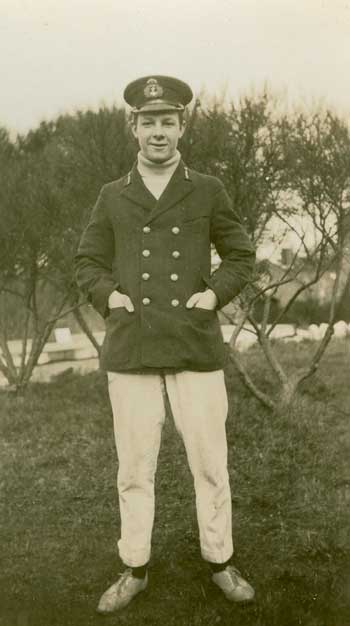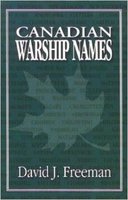From the earliest days of the Canadian Naval Service, officers and ratings wore the same uniforms as the Royal Navy (RN), complete with symbols showing ranks and trades as well as cap badges. The only thing that differentiated the Canadian seaman from his British counterpart was the title “H.M.C.S.” in the cap ribbons worn by personnel “dressed as seamen,” and the buttons on various uniforms. This situation was still in effect at the beginning of the Second World War in 1939.
My short article traces the origins of the CANADA flash or badge, still worn today on the shoulder of naval uniforms.

Harry DeWolf as a young officer-in-training. Later in his career, DeWolf voted to remove CANADA flashes from uniforms.
Late in November 1940, Naval Service Headquarters (HQ) issued Canadian Naval Order (CNO) 1097, which stated in part that “information has been received that some Canadian Naval ratings serving overseas have sewn a badge with the word ‘Canada’ on their left sleeves, similar to the Army badges. No such badge is authorized and the practice is to be checked.”
The CANADA flash first shows up as an unauthorized accoutrement worn by seamen serving overseas sometime in the summer or early fall of 1940.
Only 18 months later, in May 1942, Naval Service HQ altered naval policy. Naval Order 2087 canceled the November 1940 order and stated that ratings “may” wear CANADA badges when serving afloat in other than harbour craft, or when serving outside Canada, either afloat or ashore.
This order also stated that the lettering for the flash was to be red, 3/8ths of an inch high on a navy blue background and was to be worn on both shoulders, half an inch down from the seam. No mention is made of the badges being curved, and no source is given for obtaining such badges.
For ratings, the order is permissive in nature. In paragraph 5, however, the order reads: “Officers, regardless of where serving, are not permitted to wear ‘CANADA’ badges.”
On 29 August 1942, CNO 2262 was issued that covered personnel serving with the RN on Combined Operations. Officers and ratings were permitted to wear a shoulder title ‘Royal Canadian Navy’ and if so, ‘CANADA’ badges were not to be worn. Such badges were to be curved and consist of 3/8 inch high white letters on a navy blue background. This order is the first to mention the curved nature of the shoulder flash.
In late September 1943, Naval Order 3083 states that CANADA badges are to be worn by officers and ratings serving outside Canada and by all WRCNS personnel regardless of where they are serving. This is the first instance where the wearing of CANADA badges becomes mandatory and applies to all personnel.

Admiral Harold Grant (left) refused to wear the CANADA flash and did not accept recommendations for its use until he was forced to do so by the Minister of National Defence, Brooke Claxton – Photo Catalogue No. VR992.162.86.
This order also changed the colours of the writing on such badges. Gold lettering on navy blue background “will” be worn on the following: officers’ blue and khaki uniforms; all WRCNS officers uniforms; and Number 1 dress worn by male and female ratings. Red letters will be worn on ratings’ blue uniforms. Blue on white background will be worn on ratings white uniforms.
Barely three months later, on 1 Jan 1944, Naval Service HQ issued CNO 3285. For the first time, a drawing in the order shows the curved nature of the CANADA badge. WRCNS personnel, however, are to have the word CANADA written in a straight line.
For WRCNS ratings: they are to wear red letters on navy blue background on all winter uniforms except Number 1 Dress, which by the previous order, would be gold. Further, blue letters on a navy blue background are required on their summer uniforms.
The last order on CANADA flashes is CNO 3640, issued late in May 1944. This regulation amends the previous one and WRCNS now have blue on navy blue badges for officers’ winter and summer uniforms and the summer uniforms of ratings.
There the matter stood until February 1946. At a Naval Board meeting late in February headed by Rear Admiral Harold T. Grant, then Chief of Naval Administration and Supply, the three members present – Grant, Captain Harry DeWolf and Commodore Gus Miles – voted to remove CANADA flashes.
In October 1949, The Mainguy Report noted several “General Causes Contributing to Breakdown of Discipline” for three incidents that had occurred earlier in the year.
Cause number 22 was entitled “Absence of Canadian Identification in Navy“. This section stated in part that while officers were satisfied with their uniforms and “…the lack of Canadian identification thereon, the men were vehement in their demands that they be identified as Canadians.”
Further, the Report’s recommendation Number 26 dealt with “Canadian Badges“. The three commissioners felt that “Canada” or “Royal Canadian Navy” should appear as “…shoulder flashes on the uniforms of all ranks.”
Vice Admiral Grant, now Chief of Naval Staff, did not accept this recommendation. It took the direct intervention of the Minister of National Defence (MND), Brooke Claxton, to re-instate the badge.
Shortly after the Mainguy Report came out, trade badges were modified to include new versions of trade symbols, and every badge included a maple leaf above the symbol for that trade. The CANADA flash at the shoulder, and the maple leaf atop trade badges on the uniform lapel of all non-commissioned personnel, remain to this day.


 CFB Esquimalt Naval and Military Museum
CFB Esquimalt Naval and Military Museum CFB Esquimalt Naval and Military Museum
CFB Esquimalt Naval and Military Museum CFB Esquimalt Naval and Military Museum
CFB Esquimalt Naval and Military Museum CFB Esquimalt Naval and Military Museum
CFB Esquimalt Naval and Military Museum CFB Esquimalt Naval and Military Museum
CFB Esquimalt Naval and Military Museum